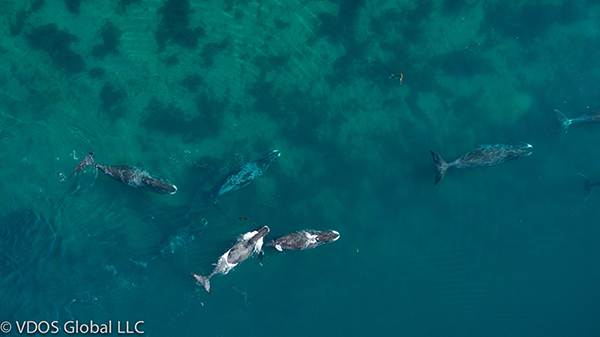The bowhead whale is the longest-living marine mammal in the world, yet many answers remain about the biology and feeding behaviour of this elusive animal.
Recently, a research team undertook what is believed to be the first intensive effort to study bowhead whales with the use of an aerial drone in the Eastern Canadian Arctic.
Using drone technology, the team captured rare high-quality images and videos of Eastern Canada-West Greenland bowhead whales during their summer feeding period in Cumberland Sound, Nunavut (just a few kilometers shy of the Arctic Circle).
“We can observe their underwater behaviour like never before, providing new insights into their feeding and social activities.”
“Much of what we know about their behaviour has come from boat-based or aerial observations from small planes,” said UBC researcher and zoology PhD candidate Sarah Fortune. “Now, thanks to the availability of drone technology and the clear water in Cumberland Sound, we can observe their underwater behaviour like never before, providing new insights into their feeding and social activities.”
Fortune, who was stationed in Pangnirtung, an Inuit hamlet, partnered with local community members who have expertise in guiding, fishing and hunting for this project.
The drones provided a safe, affordable method to obtain aerial images and video of the bowhead whales, without disturbing them in their natural habitat. The technology allowed the researchers and community members to observe behaviours in real-time, something that they would not have been able to do using conventional tagging methods and boat-based observations.
 It was the social behaviour that most fascinated Fortune. “Although it is common to find small groups of whales traveling together, we hadn’t observed how often they swim in coordinated patterns, constantly touching or rubbing one another. The team was also able to watch the whales’ daily activity patterns and found that they spent the early morning feeding in deep water and then rested, often in large groups, in shallow, coastal waters during the afternoon.”
It was the social behaviour that most fascinated Fortune. “Although it is common to find small groups of whales traveling together, we hadn’t observed how often they swim in coordinated patterns, constantly touching or rubbing one another. The team was also able to watch the whales’ daily activity patterns and found that they spent the early morning feeding in deep water and then rested, often in large groups, in shallow, coastal waters during the afternoon.”
“Not only were we able to make important observations about their foraging strategy, we were also able to collect data to help with species conservation,” said Fortune. “The pilot, Thomas Seitz (VDOS Global LLC), took thousands of images of the encountered whales, which will be used by Bill Koski (LGL Limited) to determine population size (using individual markings), age-structure, and body condition. This information will be essential to monitoring population status and health over time.”
Fortune’s research is supervised by UBC professor Andrew Trites, Institute for the Oceans and Fisheries, and Mark Baumgartner, Woods Hole Oceanographic Institution, and supported by LGL Limited (Bill Koski), and VDOS Global LLC (Brian Whiteside and Thomas Seitz), Fisheries and Oceans Canada (Steve Ferguson) and WWF-Canada (Brandon Laforest).
Video footage available here
Images available here
Please credit: LGL Limited, UBC, VDOS Global, Fisheries and Oceans Canada and WWF-Canada when using this media.
Permits: Special Flight Operation Certificate File Number 5812-11-682, University of British Columbia Animal Care Amendment A14-0064-A002, Department of Fisheries and Oceans License to Fish for Scientific Purposes S-16/17 1005-NU and Animal Use Protocol FWI-ACC-2016-09.
Tags: Andrew Trites, Arctic, bowhead whales, Cetaceans, Faculty, IOF students, Marine Mammal Research Unit, Marine mammals, whales